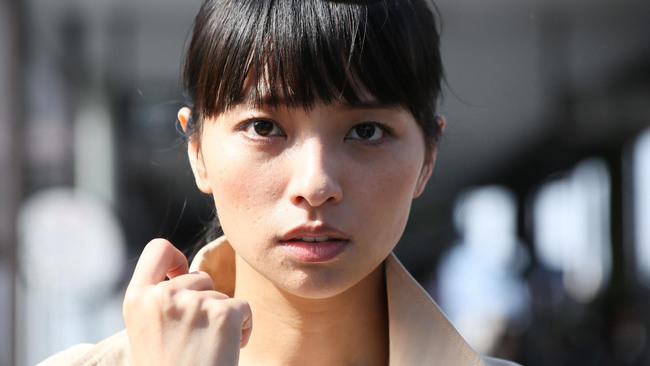Cannes 2017: Naomi Kawase’s Radiance

“The act of seeing has a special meaning in Japanese director Naomi Kawase’s Radiance, in which the job of character Misako (Ayame Misaki) is to write the scripts for the audio-assist provided for blind patrons at the movies,” writes Barbara Scharres at RogerEbert.com. “Kawase’s work demonstrates an interest in the metaphysical, whether it involves speculation on the afterlife or the meaning of life here and now. She is the rare director who portrays disability, illness or old age as normal aspects of existence, not unique tragedies. Her work can also be sentimental to a fault. Radiance is a softhearted, soft-focus, mushily forgettable film that brings the director’s more pronounced sentimental inclinations to the fore.”
“Making her fifth appearance in competition (and seventh overall) at Cannes, Kawase shows she’s sadly still nowhere near recovering that stylistic balance that propelled her to greatness in the first decade of her career,” writes Clarence Tsui in the Hollywood Reporter. “Suzaku (1997) and The Mourning Forest (2007), both prize-winners on the Croisette, remain two of the most artistically audacious and emotionally engaging films to have emerged out of contemporary Japanese cinema. Radiance is as luminous a piece of filmmaking as Kawase’s previous work, but it also contains much less substance than its gleaming sheen suggests.”
“It’s certainly difficult not to see Misako . . . as a direct Kawase surrogate,” suggests Variety’s Guy Lodge. “Blind trial listeners for the arthouse romance she’s working on respond to her descriptions with confusingly mixed feedback, with some finding her words too vague, and others declaring them overly intrusive on their own imaginations. . . . Is the filmmaker admitting her own struggle to find the balance between symbolic opacity and banality, or simply defending herself against those who identify any such conflict in her work? Is the film within the film—an apparent tearjerker that climaxes with rapturously crashing waves, tumbling sand sculptures and silk scarves lost to the breeze—a winking self-parody or intended as a serious reflection of her art?”
Misako’s “harshest critic is Nakamori (Masatoshi Nagase), a photographer who has almost totally lost his sight, yet still tries to hang on to the fragments of a seeing life,” notes John Bleasdale at CineVue. “His resentment fuels his criticisms of Misako, but gradually the two begin to understand each other better, and something like a romance forms.” But “Nakamori's musing on photography—‘I am a hunter and time is my prey’—can sound like banality wearing pompous pants.”
“‘Nothing is more beautiful than that which disappears before our eyes’ is a key line and it gives us the movie’s guiding aesthetic, or ethic,” writes the Guardian’s Peter Bradshaw. “The evanescent, elusive beauty of a flower or a cloud or a bird in flight—or simply any freeze-framed moment of existence—is entrancing because it is so brief.”
“Frequently bathed in honeyed magic-hour light, with a pleasingly diffuse and gauzy quality, the film looks terrific,” writes Wendy Ide for Screen. “Equally impressive is the subtly heightened sound design, which captures the buffeting of the world around Nakamori. So effective is the sculpting of the audio component that the overused score, an incessantly rueful piano motif, seems particularly grating.”
At Cineuropa, Fabien Lemercier argues that “Naomi Kawase’s experiment has been a successful one; as the film itself tells us, ‘to express oneself with precision is to be a master of lightness without destroying gravity’ and, ‘a film is a dive into a world bigger than oneself, a kind of parallel world to which we belong without knowing it.’”
Update, 5/26: “In spite of the film’s irregular flaws in the execution of its (potentially too many) ideas, it retains an exciting richness, operating as an abstract and poetic apotheosis of art and its importance in life,” writes Ioannis Kanonakis for the International Cinephile Society.
Update, 5/27: “It’s hard to imagine there would or could be anything more idiotic in the 2017 Cannes Completion than Naomi Kawase’s Radiance,” grumbles Little White Lies’ David Jenkins. “On a basic formal level, the film is a disaster, with most shots either inanely functional or inanely pretty. Between lethargic dialogue scenes Kawase makes sure to give us some vapid, pink-hued landscape establishing shot, or maybe some footage of wind-chimes. And there really is nothing else to it than that.”
Update, 6/2: “In previous films Kawase has used this sort of contrast between human suffering and natural beauty to deliver New Age-y epigrams—and Radiance is not totally free of them,” writes Mark Schilling in the Japan Times. “But she has also pared her story to the bone, while conveying more of her message through shimmery images and meaningful glances than portentous dialogue.”
Cannes 2017 Index. For news and items of interest throughout the day, every day, follow @CriterionDaily.



